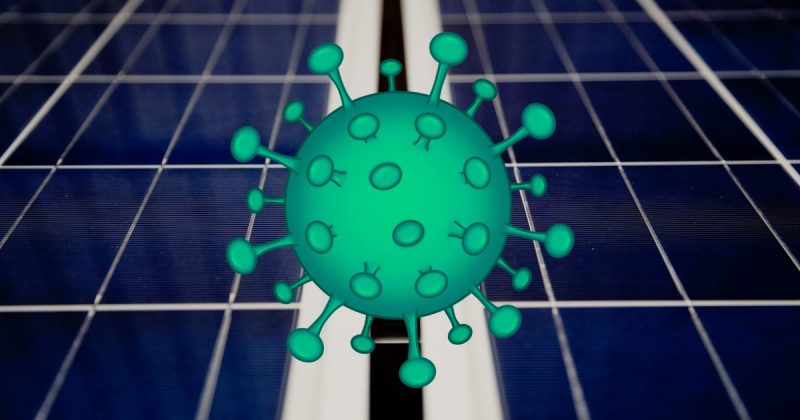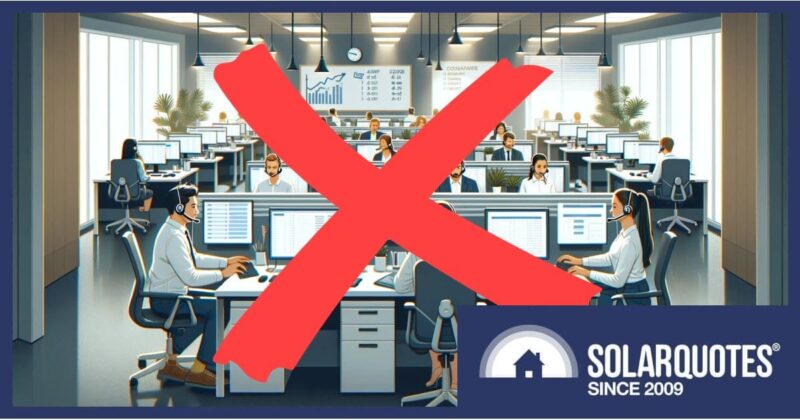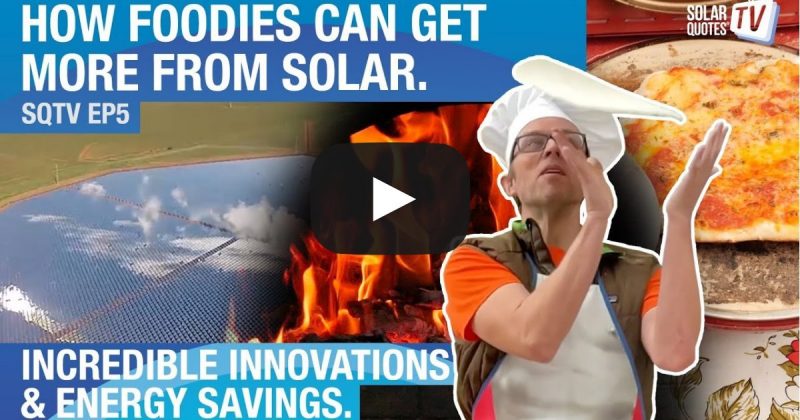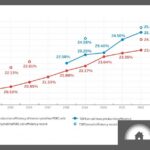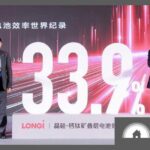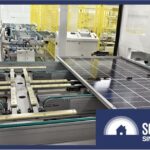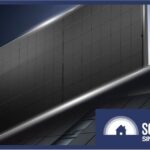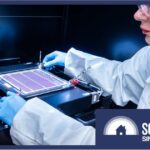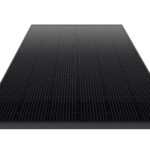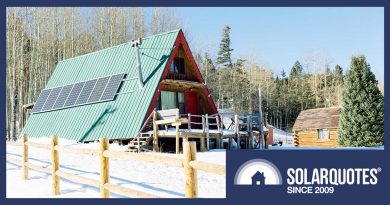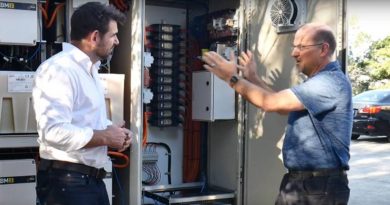Solar Panel Efficiency: Budget Brands No Longer Playing Catch-Up
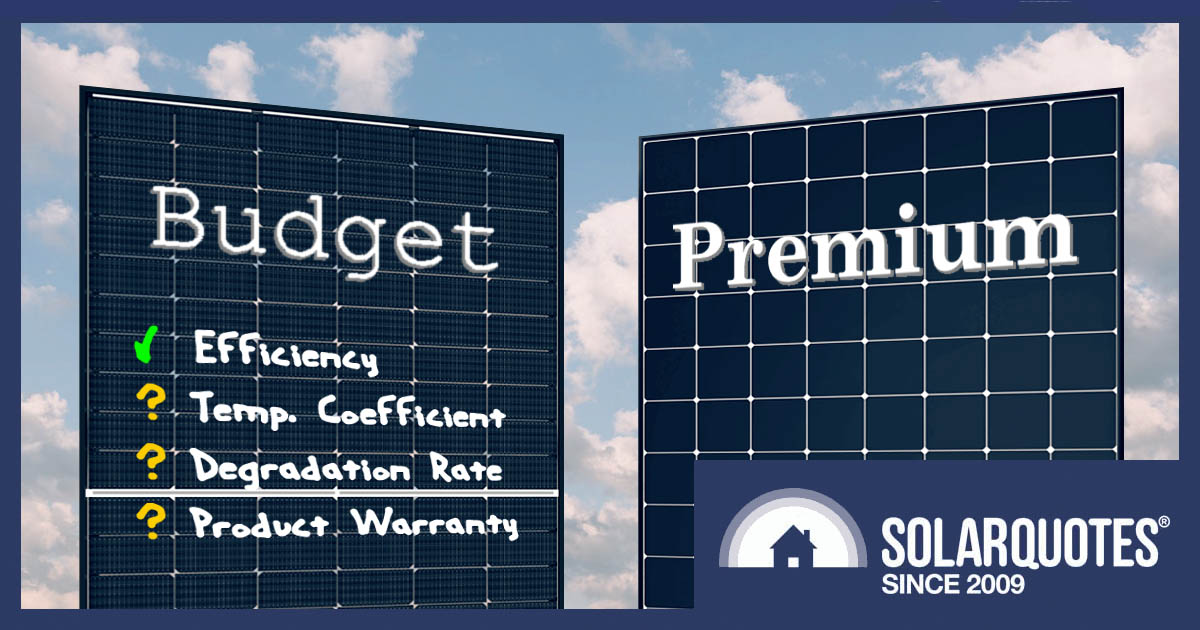
The solar industry is undergoing a seismic shift. Gone are the days when only premium brands like Sunpower dominated the solar panel efficiency charts. Budget Chinese brands are not only catching up but in some cases, surpassing their high-end counterparts.
Who are these emerging brands? How efficient are their panels, and does it matter? Will they knock off the industry stalwarts? All these questions answered and more! Read on.
Solar Panel Efficiency
Solar panel efficiency (also called solar module efficiency) refers to the percentage of sunlight a module can convert into usable electrical energy. The higher the efficiency, the smaller the panel needs to be to pump out the same power.
Don’t confuse solar panel efficiency with solar cell efficiency, as the former accounts for losses in the entire panel, including the frame and wiring, while the latter focuses solely on the silicon cells’ performance in converting sunlight into electricity.
A high-efficiency panel is a good choice for an installation with limited space, or to preserve the aesthetics of a property by having fewer modules on show.
Companies that make solar panels with the highest efficiency ratings are, quite rightly, perceived as having the highest quality control, and the most advanced cell technology, and are more likely to produce reliable products.
But is this the only metric marking a good solar panel? No! More on that later. First, let’s take a closer look at some conversion efficiencies.
Most Efficient Premium Vs Budget Solar Panels
Looking at 3 of the most efficient ‘premium’ panels on the SolarQuotes Solar Panel Comparison Table compared to the 3 of the most efficient ‘budget’ brand panels, extracting the efficiency ratings and cost per watt1 gives the following breakdown:
| Premium Panel | Efficiency | Cost per Watt |
|---|---|---|
| Sunpower Maxeon 6 (SPR-MAX6-440-E3-AC) | 23% | $1.74 |
| REC Alpha Pure-R (REC430AA) | 22.3% | $1.01 |
| QCells Q.PEAK DUO (ML-G10+ 415) | 21.1% | $0.90 |
| Budget Panel | Efficiency | Cost per Watt |
|---|---|---|
| Longi Hi-MO 6 Scientist (LR-54HTH 440~450M) | 23% | $0.53 |
| Jinko Solar Tiger Neo (JKM440N-54HL4-V) | 22.53% | $0.58 |
| Risen TOPCon (RSM108-9-4) | 22.5% | $0.60 |
Well, these sure are surprising results. When comparing efficiencies, the top budget panel (Longi) is equal to the top premium panel (Sunpower) at 23%. Not only that, when scrutinizing all panels, the budget models have a greater average efficiency than the premium ones at about half the price. How can that be?
How Do Budget Solar Panels Perform So Well?
Economies Of Scale
The three budget-branded panels in this graph are made by huge companies that dwarf the premium brands in volume. In fact, these three (Longi, Jinko, and Risen) are in the top ten Chinese companies that supplied 90% of the world’s PV modules in 2022.
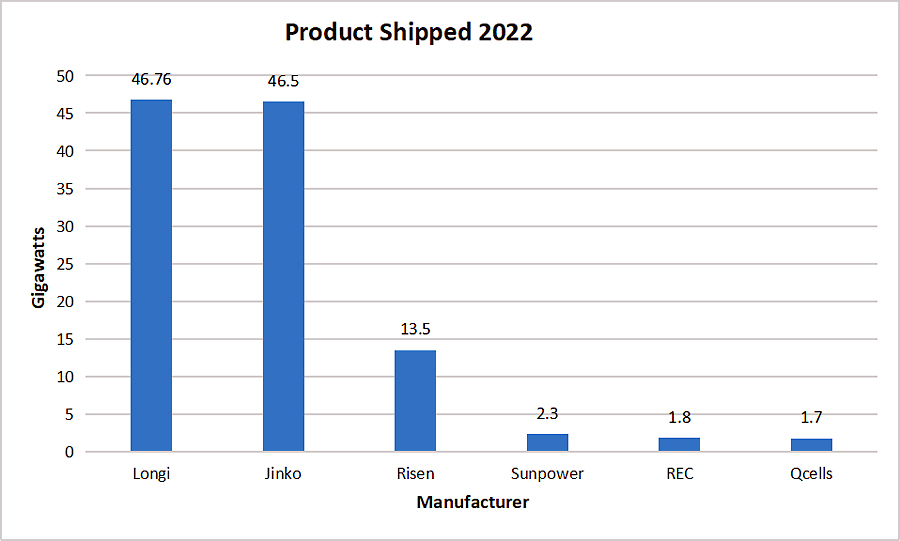
Product shipped in 2022 (gigawatts) by 6 manufacturers in this comparison.
These guys have massive production capacities, benefitting from economies of scale, lower production costs, and ultimately cheaper prices for you and me. So, they are budget brands in terms of low cost to the consumer, but the connotations of budget being low quality don’t always ring true.
Budget Brands Have The Deepest Pockets
Top solar panel manufacturers invest significantly in research and development to improve solar cell and panel efficiency. None more than the giant Chinese manufacturers. They have access to the latest innovations and very deep pockets.
Longi is one of the largest solar panel manufacturers in the world and has held a number of efficiency records over the years. The new Hi-MO 6 series are manufactured using the high-efficiency P-type Hybrid Passivated Back Contact (HPBC) cell technology.
They have finally matched the efficiency of the world leading SunPower Maxeon Series which also uses back contact energy conversion in their interdigitated back contact (IBC) solar cells.
Premium Brands Survival Strategies
Have premium brands lost their competitive edge? The technology gap that has kept them at the forefront is narrowing, but that’s only part of the picture. They’re too small to compete on price, so must find ways to stay relevant. And they are doing that.
One example is the introduction of a 40-year warranty for the SunPower Maxeon product line. This far exceeds the benchmark industry norm of 25 years. Is a 40-year warranty of any value? It certainly gives a perception of a quality product, which may be enough for the company to stay in the game.
REC Group has earned a solid reputation for being one of the best in the industry across the board in quality, reliability, support, and sustainability. They have several strategies to highlight their points of difference such as a ‘Certified Solar Professional Program’, and claims to have the lowest warranty rate in the industry.
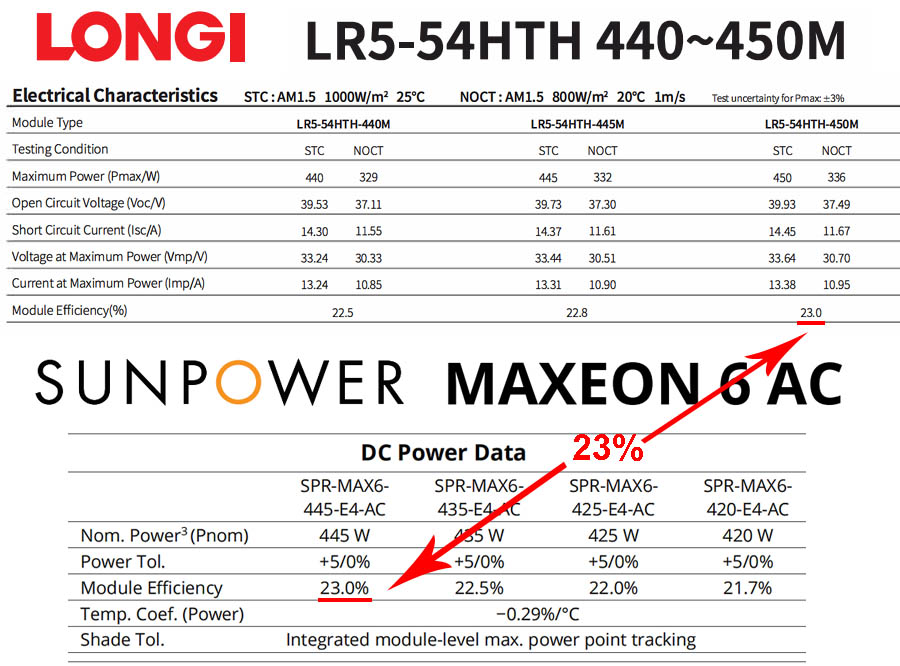
Datasheet comparison showing 23% efficiencies for top performing budget and premium solar panels. Top: Longi LR-54HTH 440~450M, Bottom: Sunpower Maxeon 6 SPR-MAX6-440-E3-AC.
Panel Efficiency Isn’t Everything!
So, a high conversion efficiency is a good sign that the module is a strong performer. However, it’s not the only metric used to identify a good-quality solar panel. A consumer should also be interested in temperature coefficient, degradation rate, and the aforementioned warranty. Let’s see how our budget panels stack up against the premium ones in those categories.
Temperature Coefficient
The temperature coefficient measures how much a solar panel’s electrical output decreases with each degree of temperature increase above the NOCT (Nominal Operating Cell Temperature). In layman’s terms – the hotter the temperature, the less efficient the panels become. The smaller the negative percentage on the datasheet, the better. For a deeper understanding of this, the recommended reading is – How To Read A Solar Panel Specification: Part #1.
Here are the compared modules in order of temperature coefficient specification. The premium REC panel wins hands down, the rest is a mixed bag.
| Premium Panel | Temperature Coefficient |
|---|---|
| REC Alpha Pure-R (REC430AA) | -0.26%/°C |
| Sunpower Maxeon 6 (SPR-MAX6-440-E3-AC) | -0.29%/°C |
| QCells Q.PEAK DUO (ML-G10+ 415) | -0.34%/°C |
| Budget Panel | Temperature Coefficient |
|---|---|
| Longi Hi-MO 6 Scientist (LR-54HTH 440~450M) | -0.29%/°C |
| Jinko Solar Tiger Neo (JKM440N-54HL4-V) | -0.30%/°C |
| Risen TOPCon (RSM108-9-4) | -0.30%/°C |
Degradation Rate
The degradation rate indicates the annual percentage at which a solar panel’s efficiency decreases over time. The figure is typically measured from year two because, during the first year of a solar panel’s operation, it may experience a ‘settling-in’ period.
Once again, a smaller number is better, indicating less degradation annually over the specified period. In this comparison, two premium panels, Sunpower and REC, offer superior specs to all others.
| Premium Panel | Degradation Rate (from year 2) |
|---|---|
| Sunpower Maxeon 6 (SPR-MAX6-440-E3-AC) | 0.25% per year |
| REC Alpha Pure-R (REC430AA) | 0.25% per year |
| QCells Q.PEAK DUO (ML-G10+ 415) | 0.5% per year |
| Budget Panel | Degradation Rate (from year 2) |
|---|---|
| Longi Hi-MO 6 Scientist (LR-54HTH 440~450M) | 0.4% per year |
| Jinko Solar Tiger Neo (JKM440N-54HL4-V) | 0.4% per year |
| Risen TOPCon (RSM108-9-4) | 0.4% per year |
Product Warranty
The product warranty for solar panels covers defects in materials and workmanship for a specified period. An overwhelming amount of information is written about this on the SolarQuotes website.
In terms of product warranty periods for the compared panels, Sunpower Maxeon stands out a mile with a 40-years. Unfortunately that’s not the whole story with this particular module, as the microinverter, which is integrated as part of the panel, is only warranted for 25 years. And another minor detail – will the manufacturer be around in 40 years to honour a warranty?
Performance Warranty
The performance (or power) warranty assures that the solar panels will maintain a certain level of energy output over the warranted timeframe. Once again, the premium panels REC and Sunpower Maxeon reign supreme with a whopping 92%.
| Premium Panel | Product Warranty | Performance Warranty |
|---|---|---|
| Sunpower Maxeon 6 (SPR-MAX6-440-E3-AC) | 40 years | 92% |
| REC Alpha Pure-R (REC430AA) | 25 years | 92% |
| QCells Q.PEAK DUO (ML-G10+ 415) | 25 years | 86% |
| Budget Panel | Product Warranty | Performance Warranty |
|---|---|---|
| Longi Hi-MO 6 Scientist (LR-54HTH 440~450M) | 25 years | 88.9% |
| Jinko Solar Tiger Neo (JKM440N-54HL4-V) | 25 years | 87.4% |
| Risen TOPCon (RSM108-9-4) | 25 years | 87.4% |
Beyond Solar Panel Efficiency: It’s Your Choice
If your primary concern is getting the most efficient solar panel for the least amount of money, and you’re not too fussed about super-long-term warranties or a slight edge in performance then budget panels are a compelling option.
Otherwise, if you’re looking for a long-term, robust solution and are willing to invest upfront for lower degradation, more power on hot days and better warranties, then premium solar panels could be worth the extra cash.
Footnotes
- The cost-per-watt figures in the above comparison were used to distinguish the premium from the budget products, and that’s all. The actual dollar values are skewed because the most efficient panel in the premium category (Sunpower Maxeon 6) is an AC panel. Unlike all the others, which are DC, it has an integrated microinverter on each module, and so is more expensive.
Original Source: https://www.solarquotes.com.au/blog/budget-solar-panel-efficiency/
